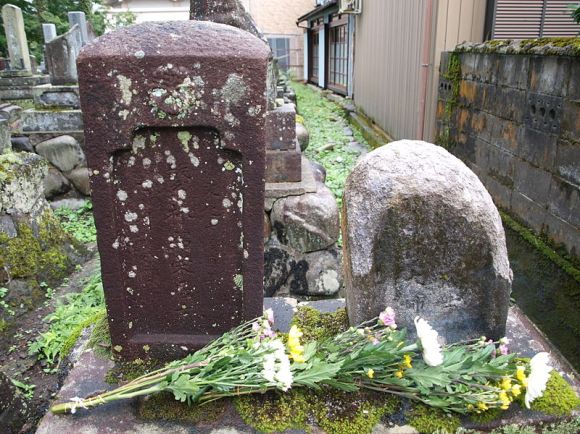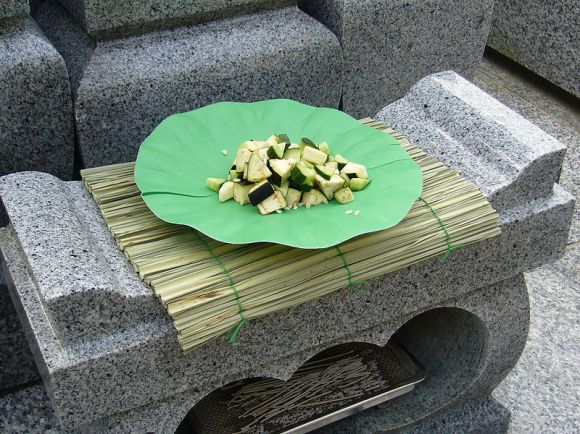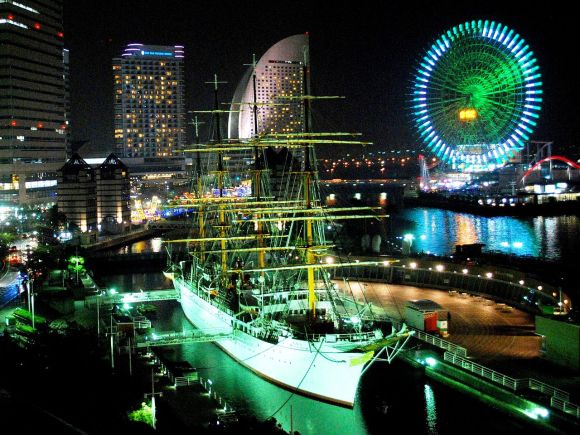
Whenever people ask me what I want to happen after I die, I always tell them I want a Super Mario-themed funeral where, at the end of the ceremony, the Mario death music plays and my casket is launched a few feet up in the air, then allowed fall down into the earth. I’ve always thought that would be a pretty cool way for friends and family to send me off, but the actual location of the funeral – or even really what happened to my body afterwards – has never been all that important to me.
Westerners have surprisingly little ritual when it comes to death. There’s usually a wake or a funeral, and then, if you’re lucky, every couple of years Solid Snake comes by to stand in front of your grave, look grim and deliver a two-hour monologue about the horrors of war. The Japanese, on the other hand, make a point to visit and pay respects to the dead every year through somewhat ritualized ohakamairi, so the location of your grave is an important thing to consider.
So important, apparently, that specialty online grave retailer Ohakamagokorokakaku (“ohakamago”) is considering offering a service to move the graves of loved ones, and recently conducted a survey among Japanese people asking: “Where would you most like to ‘live’ after death?”
Now, since “Mom’s basement,” or “in a bitchin’ Pharaoh tomb” would be the obvious answers for nearly everyone if they were options, the company narrowed choices down to just Japanese cities. Here’s how they rank, based on the number of “I’d probably like to have my earthly remains moved here” responses:
1) Yokohama (Kanagawa)
2) Kamakura (Kanagawa)
3) Kawasaki (Kanagawa)
4) Hachioji (Tokyo)
5) Minato-ku (Tokyo)
6) Sagamiharashi (Kanagawa)
6) Chiba (Chiba)
6) Saitama (Saitama)
7) Meguro (Tokyo)
7) Setagaya-ku (Tokyo)
7) Tama (Tokyo)
7) Ichikawa (Chiba)
(The repeating numbers represent ties)
Okay, so now that we’ve had a little fun with the survey, it’s time for some qualifications:
Despite the tongue-in-cheek survey title, Japanese graves are usually small plots where generation after generation are “entombed” – remember, cremation is the norm in Japan so there aren’t usually bodies to worry about. Plots are often located on or near temple grounds and, if a family has enough money, there’s a large altar-style cement gravestone to mark the place. This is the thing that’s moved when ohakamago talks about moving graves.
So, what the survey is really asking is: Where would you most like your family’s gravestone to be located? In other words, “what city would you most like you and your entire family to live and die in?”
So, Yokohama got first place by a long shot because it’s a beautiful city with convenient transport links, and Kamakura came second because there’s tons of nature and it’s near the ocean. Convenience seemed to play a major factor, as those surveyed said that they live anywhere from 30 minutes to 24 hours (one-way) from their family’s grave site and that they were twice as likely to visit more than once a year if the site was close.
Family gravestone relocation services have existed in the past, often to move graves from derelict graveyards in far-flung locations – graveyards falling into disarray because they lose people to care for them being a somewhat common problem – but what ohakamago is proposing is more of a Kanto area city-to-city relocation service.
Indeed, when the survey asked those who said they lived two-plus hours from their family grave plot, around 26% said imagined it would be necessary to move it some day.
We could go on but we’ll stop here. The survey results go into a whole bunch of other details that, honestly, would put this piece at a few pages long, so we’re not going to go into them. Besides, it’s pretty dry and we don’t want to… bore you to death.
Source: PR Times
Photos: Kazuo Ogasawara, Katorisi, Captan76 via Wikimedia Commons



 Japanese taxi company offers service to visit family graves for those who can’t travel themselves
Japanese taxi company offers service to visit family graves for those who can’t travel themselves Here’s a little tip from a Buddhist monk for anyone spooked by cemeteries at night
Here’s a little tip from a Buddhist monk for anyone spooked by cemeteries at night Bones of over 1,500 people found at Osaka Station area construction site
Bones of over 1,500 people found at Osaka Station area construction site Increasing number of Japanese ditching traditional attitudes about weddings and funerals
Increasing number of Japanese ditching traditional attitudes about weddings and funerals Three main reasons why fewer and fewer Japanese people are having funerals
Three main reasons why fewer and fewer Japanese people are having funerals Our reporter takes her 71-year-old mother to a visual kei concert for the first time
Our reporter takes her 71-year-old mother to a visual kei concert for the first time McDonald’s new Happy Meals offer up cute and practical Sanrio lifestyle goods
McDonald’s new Happy Meals offer up cute and practical Sanrio lifestyle goods Disney princesses get official manga makeovers for Manga Princess Cafe opening in Tokyo
Disney princesses get official manga makeovers for Manga Princess Cafe opening in Tokyo Is the new Shinkansen Train Desk ticket worth it?
Is the new Shinkansen Train Desk ticket worth it? Tokyo’s most famous arcade announces price increase, fans don’t seem to mind at all
Tokyo’s most famous arcade announces price increase, fans don’t seem to mind at all Randomly running into a great sushi lunch like this is one of the best things about eating in Tokyo
Randomly running into a great sushi lunch like this is one of the best things about eating in Tokyo Osaka’s creepy cute mascot speaks for first time, adds more fuel the creepy OR cute debate【Video】
Osaka’s creepy cute mascot speaks for first time, adds more fuel the creepy OR cute debate【Video】 Kyushu-exclusive Black Mont Blanc goes nationwide in a “Special” way
Kyushu-exclusive Black Mont Blanc goes nationwide in a “Special” way Beautiful new Final Fantasy T-shirt collection on the way from Uniqlo【Photos】
Beautiful new Final Fantasy T-shirt collection on the way from Uniqlo【Photos】 There’s a park inside Japan where you can also see Japan inside the park
There’s a park inside Japan where you can also see Japan inside the park We try out “Chan Ramen”, an underground type of ramen popular in the ramen community
We try out “Chan Ramen”, an underground type of ramen popular in the ramen community New Studio Ghibli bedding sets are cool in all senses of the word
New Studio Ghibli bedding sets are cool in all senses of the word Our Japanese reporter visits Costco in the U.S., finds super American and very Japanese things
Our Japanese reporter visits Costco in the U.S., finds super American and very Japanese things Foreign English teachers in Japan pick their favorite Japanese-language phrases【Survey】
Foreign English teachers in Japan pick their favorite Japanese-language phrases【Survey】 New Pokémon cakes let you eat your way through Pikachu and all the Eevee evolutions
New Pokémon cakes let you eat your way through Pikachu and all the Eevee evolutions Japanese convenience store packs a whole bento into an onigiri rice ball
Japanese convenience store packs a whole bento into an onigiri rice ball Hanton rice — a delicious regional food even most Japanese people don’t know about, but more should
Hanton rice — a delicious regional food even most Japanese people don’t know about, but more should Final Fantasy, Kingdom Hearts, and Dragon Quest pet product line announced by Square Enix
Final Fantasy, Kingdom Hearts, and Dragon Quest pet product line announced by Square Enix Studio Ghibli releases Kiki’s Delivery Service chocolate cake pouches in Japan
Studio Ghibli releases Kiki’s Delivery Service chocolate cake pouches in Japan Japan’s bone-breaking and record-breaking roller coaster is permanently shutting down
Japan’s bone-breaking and record-breaking roller coaster is permanently shutting down New definition of “Japanese whiskey” goes into effect to prevent fakes from fooling overseas buyers
New definition of “Japanese whiskey” goes into effect to prevent fakes from fooling overseas buyers Foreign passenger shoves conductor on one of the last full runs for Japan’s Thunderbird train
Foreign passenger shoves conductor on one of the last full runs for Japan’s Thunderbird train Kyoto bans tourists from geisha alleys in Gion, with fines for those who don’t follow rules
Kyoto bans tourists from geisha alleys in Gion, with fines for those who don’t follow rules Studio Ghibli unveils Mother’s Day gift set that captures the love in My Neighbour Totoro
Studio Ghibli unveils Mother’s Day gift set that captures the love in My Neighbour Totoro Domino’s Japan now sells…pizza ears?
Domino’s Japan now sells…pizza ears? Toyota built a life-sized Miraidon Pokémon and are letting people test drive it this weekend
Toyota built a life-sized Miraidon Pokémon and are letting people test drive it this weekend New Japanese KitKat flavour stars Sanrio characters, including Hello Kitty
New Japanese KitKat flavour stars Sanrio characters, including Hello Kitty Sales of Japan’s most convenient train ticket/shopping payment cards suspended indefinitely
Sales of Japan’s most convenient train ticket/shopping payment cards suspended indefinitely Sold-out Studio Ghibli desktop humidifiers are back so Totoro can help you through the dry season
Sold-out Studio Ghibli desktop humidifiers are back so Totoro can help you through the dry season Japanese government to make first change to romanization spelling rules since the 1950s
Japanese government to make first change to romanization spelling rules since the 1950s Ghibli founders Toshio Suzuki and Hayao Miyazaki contribute to Japanese whisky Totoro label design
Ghibli founders Toshio Suzuki and Hayao Miyazaki contribute to Japanese whisky Totoro label design Doraemon found buried at sea as scene from 1993 anime becomes real life【Photos】
Doraemon found buried at sea as scene from 1993 anime becomes real life【Photos】 Tokyo’s most famous Starbucks is closed
Tokyo’s most famous Starbucks is closed One Piece characters’ nationalities revealed, but fans have mixed opinions
One Piece characters’ nationalities revealed, but fans have mixed opinions We asked a Uniqlo employee what four things we should buy and their suggestions didn’t disappoint
We asked a Uniqlo employee what four things we should buy and their suggestions didn’t disappoint Princesses, fruits, and blacksmiths: Study reveals the 30 most unusual family names in Japan
Princesses, fruits, and blacksmiths: Study reveals the 30 most unusual family names in Japan Studio Ghibli’s new desktop Howl’s Moving Castle will take your stationery on an adventure
Studio Ghibli’s new desktop Howl’s Moving Castle will take your stationery on an adventure Kyoto City planning to sell cremated people’s precious metal fillings for millions of yen
Kyoto City planning to sell cremated people’s precious metal fillings for millions of yen Yokohama ranks as most desirable city for living in Kanto for the second year in a row
Yokohama ranks as most desirable city for living in Kanto for the second year in a row Pet crematorium in Japan was burning trash with animals for more than 10 years
Pet crematorium in Japan was burning trash with animals for more than 10 years Elderly Japanese man goes Pokémon Go hunting at wife’s grave, offers sweet tribute to lost love
Elderly Japanese man goes Pokémon Go hunting at wife’s grave, offers sweet tribute to lost love Japanese supermarket’s funeral ad sparks controversy, debate over “blasphemy”
Japanese supermarket’s funeral ad sparks controversy, debate over “blasphemy” Names of 10 Kyoto Animation arson victims released, family and friends offer words of remembrance
Names of 10 Kyoto Animation arson victims released, family and friends offer words of remembrance How much money do you need to live in your own apartment in Japan?【Survey】
How much money do you need to live in your own apartment in Japan?【Survey】 Company PET partners with Kyoto temple to offer genuine funeral services for beloved pets
Company PET partners with Kyoto temple to offer genuine funeral services for beloved pets New Japanese augmented-reality service lets you meet with deceased loved ones at their graves
New Japanese augmented-reality service lets you meet with deceased loved ones at their graves Japanese sign uses the power of spirits to strike fear into passers-by and stop them from littering
Japanese sign uses the power of spirits to strike fear into passers-by and stop them from littering Japanese graves and Shinto shrines under attack by bears for their sweet, sweet honey
Japanese graves and Shinto shrines under attack by bears for their sweet, sweet honey The top 20 anime series fans want to be watching at the moment they die
The top 20 anime series fans want to be watching at the moment they die A stone-engraver impresses with Love Live gravestones and wine bottles 【Photos】
A stone-engraver impresses with Love Live gravestones and wine bottles 【Photos】 Japanese men rank the top 10 complaints they hope to never hear from their wives
Japanese men rank the top 10 complaints they hope to never hear from their wives Tokyo’s sushi spirit shrine, where the souls of seafood slumber
Tokyo’s sushi spirit shrine, where the souls of seafood slumber Studio Ghibli producer dishes the dirt on Hayao Miyazaki, Your Name, and their next big project
Studio Ghibli producer dishes the dirt on Hayao Miyazaki, Your Name, and their next big project
Leave a Reply